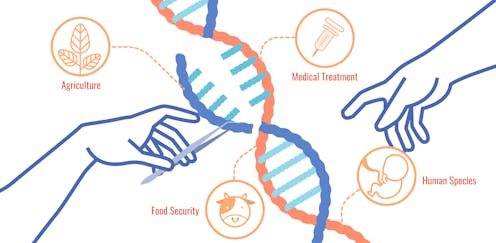CRISPR isn’t just for editing human embryos, it also works for plants and bugs: 5 essential reads
You may not agree with using the gene-editing tool, CRISPR, to alter the DNA of human babies. But what about using it to engineer plants? Or wipe out one of the world's most dangerous creatures?

Editor’s note: As we come to the end of the year, Conversation editors take a look back at the stories that – for them – exemplified 2018.
If you’ve been stunned by all the alarming reports of gene-edited babies, you might have the impression that the only purpose of CRISPR, the genetic technology that enables biologists to edit DNA, is meddling with the human genome. You may be relieved to learn, as I know I was, that engineering human traits isn’t so simple. Cecile Janssens of Emory University explains that the most desirable traits are the product of dozens or hundreds of genes interacting with the environment. Such traits can’t be designed by fiddling with a gene or two.
Over the last year of covering CRISPR applications, I’ve come to recognize that a better reflection of the gene-editing technology’s promise is visible in the labs of scientists creating new varieties of plants.
1. CRISPR and crops
Given all the controversy associated with genetically modified crops, you might be wondering whether CRISPR is any different. Plant geneticist Yi Li from the University of Connecticut argued that CRISPR’s precision makes it different from GMOs because no foreign genes from other species are added to the plant. Li used CRISPR to engineer citrus trees that are resistant to the greening disease Huanglongbing, which has devastated citrus crops in Florida and other parts of the world.
2. CRISPR and organic farming
Plant pathologist Rebecca Mackelprang, University of California, Berkeley, suggests that some forms of CRISPR editing mimic naturally occurring genetic mutations that arise spontaneously in nature. Furthermore she explains how CRISPR is a way for academic researchers to enter the world dominated by Big Ag.
3. CRISPR and taming wild plants
CRISPR may also be a vital tool as the changing climate makes it difficult to grow crops. Nathan Reem and Esperanza Shenstone of Cornell University explain how wild plants with crop potential can be rapidly domesticated using gene editing. They worked on the groundcherry and showed how the plant could be made to grow more compactly and produce larger fruit. Similar modifications could help struggling crops adapt to warmer conditions. To do the same thing using traditional plant breeding techniques, by comparison, could take hundreds of years.
4. CRISPR and public health
When comes to public health, there are many useful applications that have nothing to do with editing the DNA of human embryos. Jay Shendure’s team at the University of Washington used CRISPR as a tool to figure out which mutations in the breast cancer genes 1 and 2 – BRCA 1 and BRCA 2 – were harmless and which ones were likely to dramatically raise the risk of breast or ovarian cancer.
5. CRISPR and malaria
A more controversial application of CRISPR is engineering a gene drive – a genetic mechanism that helps a trait spread through a population faster than it would naturally. Andrea Crisanti and Kyros Kyrou show how a gene drive can successfully crash a population of mosquitoes in their laboratory. The intended application: wiping out mosquitoes that spread malaria. It’s a radical and irreversible approach – which is why it is still years away from use in the field. But it offers a peek into genetic approaches to controlling this and other mosquito-borne diseases.
Read These Next
Newly discovered link between traumatic brain injury in children and epigenetic changes could help p
Some children recover better after traumatic brain injury than others, despite appearing similarly to…
How crime in Brazil drags down the economy and heaps economic pain on the nation’s poor
The percentage hit on Brazil’s GDP could be in the double digits.
Outside the West, the Kundalini tradition presents a model of the ‘divine feminine’ beyond binary ge
Drawn from tantric traditions, Kundalini points to spiritual practices that go beyond traditionally…






